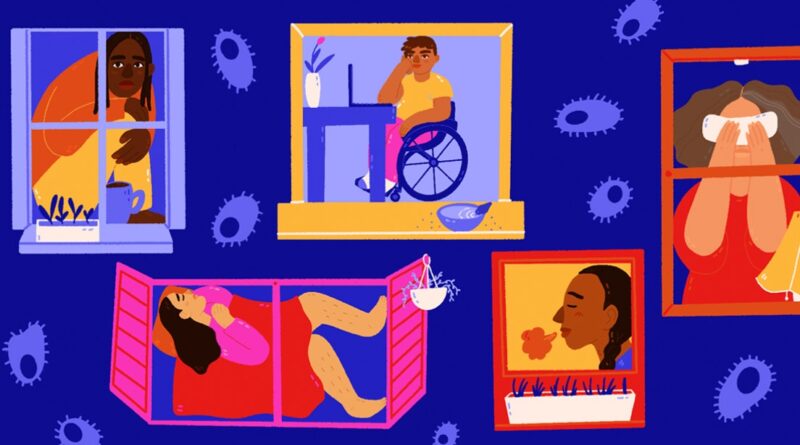What Long COVID Is Like For These 14 People
Disability (In)Justice is a package exploring where the fight for disability rights and inclusion stands.
The COVID-19 pandemic has been filled with unexpected and difficult health challenges, many of which researchers are beginning to understand better. But among the mysteries that still remain is long COVID — a complex and often taxing illness that we still really don’t understand.
Long COVID (also classified as “post-COVID conditions” by the Centers for Disease Control and Prevention) is a group of symptoms that can form a complex chronic illness, triggered by a COVID-19 infection. Symptoms of long COVID are often (though not always) multi-systemic, and can be disabling, including fatigue, cognitive dysfunction, neurological issues, gastro-intestinal symptoms, and post-exertional malaise (PEM) – symptoms worsening after mental, emotional, or physical exertion. Long COVID can persist for weeks, months, or years, and shares similarities with other chronic illnesses, like ME/CFS and dysautonomia, which are also sometimes triggered by a viral infection. Researchers estimate that long COVID may develop in as many as 30% of all COVID-19 cases (including initially mild or asymptomatic cases), though other research suggests much lower numbers. Some cases may go uncounted, and long COVID is an umbrella term that includes a range of experiences. Current COVID-19 vaccines may not prevent long COVID, according to a 2022 study, but they may reduce the risk slightly overall.
Because there’s so little information on it, some people with long COVID are initially surprised to be experiencing disabling health issues. For a lot of young people, long COVID is the first time they’ve had to grapple with a chronic health issue, or the possibility of permanent disability. For others, earlier life experiences with disability have provided crucial frameworks through which to understand long COVID-related struggles, like unemployment, loss of relationships, and access issues.
Long COVID can impact everyone differently, and symptoms can be wide-ranging, so we talked to some people who are experiencing the condition. They talk about symptoms, what it feels like to have long COVID, and the many ways it’s impacted their lives. Here, 14 long-haulers describe life with long COVID.
Sarah Louise, 31
When the pandemic hit, Sarah was working as a neuro-rehab assistant, but was redeployed to an intensive care unit. Antibody tests, she said, later revealed she had likely been infected with COVID, though she wasn’t aware. She said she was reinfected in October 2021 and again in March 2022, and her health has significantly deteriorated. Sarah described her condition as “toward the severe end of the severity spectrum.” She deals with limited mobility and debilitating cognitive dysfunction that makes it very difficult to read or concentrate. In order to get through the day “without crashing,” Sarah said she has to rest in a darkened room for at least 20 minutes after every 30 minutes of activity. She still hopes to one day become a physiotherapist, using her experience as a patient to help others. “I will never…assume that a patient is pretending to be ill or that their illness is their fault,” Sarah said.
Morgan Baker, 22
Morgan got COVID-19 in July 2021, while singing with the Yale Whiffenpoofs. Since then, they said they have developed symptoms consistent with postural orthostatic tachycardia syndrome (POTS), a form of dysautonomia, and ME/CFS. After Morgan got sick, college became “really difficult.” At first, Morgan said they tried to overcompensate, but pushing through worsened their symptoms. “I was in a post-exertional malaise spiral, though I didn’t know it at the time,” Morgan said. Eventually, Morgan learned more about long COVID, organized a chronic illness support group at Yale, and was approved for accommodations through Yale’s disability office. During her worst symptoms, Morgan practiced a form of “radical acceptance,” to avoid pushing herself too hard again. “I [worked] on…identifying my needs and honoring them, even when doing so might look like laziness or giving in,” they said.
Holly MacDonald, 31
Before she contracted COVID, Holly felt her career was poised to “shift and expand.” She was working as the director of a small agency leveraging pop culture for social impact, and DJ-ing on the side. Then, long COVID hit, and Holly’s “ability to work totally disappeared.” After six months had passed, Holly wondered: “what if I don’t get better?” Since then, she said she’s experienced some improvement, but that her life “sits within limitations now.” To navigate this transition, she’s formed a care network called Bed Collective that meets via Zoom. “The six of us have been a crucial collective of support for each other,” she said.
Jenna Bitar, 30
Jenna is a queer Palestinian American organizer and artist. Before the pandemic, they lived a busy life that “relied on grind culture.” When Jenna contracted COVID-19, they said they were forced to quit their “beloved” job at a media advocacy organization. While Jenna was born and raised in New York City, the sensory stimulation of the city now exacerbates their symptoms, so they’ve spent the past year in lower-stimulus environments, burning through their limited savings. Jenna said it’s impossible to predict long COVID symptoms, and hard to plan for the future. “My forms of activism are evolving as I learn to contextualize my needs,” they explained.
Ashley Jackson, 23
Before she got COVID-19, Ashley was a full-time actress, studying screenwriting at Spelman college. When she first began exhibiting signs of long COVID, she worried that stigmas about chronic illness would hinder her career in the entertainment industry. Because of the risk of reinfection, Ashley said she initially couldn’t consider jobs on-set. Instead, she’s been working remotely in Disney’s General Entertainment’s Apprenticeship Program; she hopes to one day start her own production company. Ashley has also found a team of medical professionals who believe her, after initially facing what she called medical racism. “Processing these changes while…in my early 20s is not an easy feat,” she said. “My value system has changed for the better.”
Ryan McDonagh, 30
Ryan was living in London and finishing a masters degree when he developed long COVID. As a child, Ryan was diagnosed with cerebral palsy, and more recently, with epilepsy — experiences he said provided him with useful insights for navigating long COVID. He said that he’s faced more skepticism from providers about long COVID than he has for other disabilities. Ryan spent the majority of his first year with long COVID in his bedroom, and is still “housebound” and more dependent on others than he was before the pandemic. “It’s taught me how important it is [to stay] creative,” he said. “I still make art everyday and don’t plan to stop. I cherish it more than ever.”
Anna Roberts-Gevalt, 34
When she first became sick, Anna was getting an MFA in sculpture and working as a freelance musician and composer. After developing long COVID, Anna relied on pandemic unemployment assistance until the program ended in September 2021. Since then, she has been running through her savings and relying on her family for financial support. Recently, Anna said her application for Social Security Disability Insurance was denied. This summer, Anna re-entered graduate school, after two years, and has been advocating for hybrid class options so she can participate on days when she’s too sick to leave her bed. Anna urges non-disabled people to think more about accessibility: “Consider it not an ‘extra’ effort, but a step towards a more liberated and truly inclusive world.”
Melodie Stancato, 31
For the last five years, Melodie has been living in the same apartment in Crown Heights. When they got sick with COVID, Melodie was working at a bookstore in Queens, teaching singing lessons to children, and running a performance collective in Bushwick. “I was quite active in the ‘before-times’,” they said. “It’s difficult to remember that version of myself now.” Since contracting long COVID, Melodie has learned that post-viral illnesses are not new, and has immersed themself into the “long history of medical neglect and mistreatment” of chronically ill people, tackling their own internalized ableism. “Though my life has been marked by sickness…it wasn’t until this year that I was able to understand my experience through a lens of chronic illness,” Melodie said.
Iz Floresta, 41
Iz worked in shipping and receiving in the cannabis industry in Canada when the pandemic hit. As an autistic person, Iz was already familiar with the impact of ableism on people with invisible disabilities, but these issues were “compounded” when Iz got long COVID. “I have always felt like an outsider, but I have felt further alienated, as I watched the world seemingly move on from the pandemic, while little has changed for me,” Iz said. Iz grew up poor in the U.S. with limited access to healthcare; both they and their partner were immigrants to Canada. After they both developed long COVID, they said they faced homelessness and returned to Iz’s partner’s home country of Brazil, where they now live with friends on an Indigenous Reservation.
Bilen Berhanu, 42
Bilen is a full-spectrum doula, and identified as chronically ill prior to catching COVID in March, 2020. She said past experiences with illness helped her find language and community support for what she was experiencing when she caught COVID. But, her experience wasn’t easy. Bilen said she has experienced medical bias and trauma. “I feel no more capable of navigating our broken care system than I did before,” she said. “I had very little trust and now I have none.” Bilen lost income and a major part of her emergency savings when she got sick. She’s since returned to working with a much smaller pool of clients. Bilen also expanded her doula practice to include grief and death work, which she said is “directly informed by the overwhelm of collective grief of this season of life.”
Ruth Castellanos, 40
Before she got sick with COVID-19, Ruth was a part-time college instructor, running two small businesses. “I had finally found a balance and joy,” she said. Earlier in her life, Ruth was diagnosed with a hypermobility spectrum disorder, which she said taught her a lot about how to navigate medical systems. Still, she said she has faced gender bias from providers; it was only after she started bringing her husband to appointments that this treatment improved. Looking back, Ruth wishes she would warn herself about post-viral illnesses. “I didn’t know one could become sick after a viral infection,” she said. “I feel robbed of knowledge.”
Una Aya Osato, 39
Una is a performer, writer, organizer, and sex educator. Before the pandemic, Una said she “conceptually understood and supported disability justice, but didn’t actually get it.” Long COVID changed that. Una’s symptoms make it hard to work; screen-time can trigger migraines and constantly shifting symptoms make it hard to plan in advance. “I’ve really had to adjust what my career goals and the timeline for them are,” they explained. Una has struggled to find Western doctors who can help, but has found some relief through Chinese medicine and other non-Western practices. After her medical leave ran out, Una said she was forced to return to teaching in-person. “I love my students and my co-workers [but] it’s really taxing on my body,” they said.
aerik woodams, 42
Before COVID, aerik identified as “mad, sick, and neurodivergent.” For the past 15 years, they said they have been living in public housing with a close friend, relying on social assistance, and participating in “care sharing, mutual aid, and activism within queer and disabled communities.” When they developed long COVID, these networks became even more vital. For a long time, aerik didn’t have consistent access to the internet, but shortly before the pandemic, someone in their network helped them get online. They began exploring virtual communities for chronically ill and disabled people. “My pre-COVID self already knew that systems were never designed for multiply marginalized disabled folx to thrive,” aerik wrote in an email. “What I hadn’t completely absorbed yet was the extent to which disabled folx can and always have co-created alternatives.”
Alice,* 49
As a development consultant, freelance writer, and community leader, Alice was often busy, but sometimes struggled to make ends meet. After she was infected with COVID-19 two times in 2020, she said she no longer had “the strength and stamina to juggle multiple assignments.” Alice said her current building has pests, unsafe water, and no heat or working stove. Because she lost her sense of smell from COVID, she initially didn’t notice a gas leak in her kitchen. “I’ve suffered in silence, embarrassment, and exhaustion…fighting to get repairs done [with] limited energy from long COVID,” she explained. “I make too little to afford another apartment, but I make too much hourly to qualify for rental assistance and low-income housing.” Alice is now looking at every affordable housing alternative she can find – from eco-villages to housing co-ops. “There aren’t a lot of options for people who have nontraditional and inconsistent incomes,” she said.




